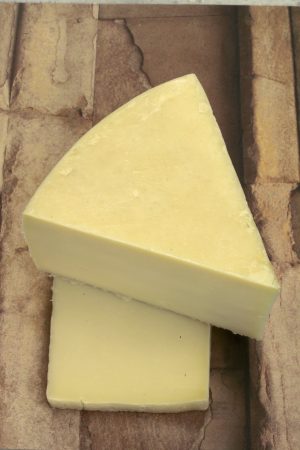Kasseri is one of the best-known Greek cheeses, a table cheese par excellence. Kasseri is semi-hard with a unique, unmistakable flavor and buttery, pleasant texture. It has a mild, mellow, and faintly sweet flavor. It is lightly salty and its texture is dense and pliant. Pale yellow to white in color, it has a subtle, milky aroma.
It is enjoyed as a table cheese, often served with bread and olives, and used to top pizzas or in savory pies. One type of pie, the pita kaisarias, is made with Kasseri, buttery filo pastry, pastourma (spicy cured beef), and tomatoes. It is a wonderful table cheese to enjoy with full-bodied white wines.
The best is made from 100% sheep’s milk, but goat’s and up to 10% cow’s milk may also be added. The cheese was awarded Protected Designation of Origin status in 1996 and is produced, by law, in four specific regions: Xanthi in Thrace; Macedonia, Thessaly, and on the island of Lesvos.
The cheese has a history that relates it to similar cheeses found throughout the Balkans. It is in the pasta filata family of cheeses. Traditional kasseri is made by hand-kneading the warmed, malleable curd to just the right consistency. It is similar to the Kashkaval found in various Balkan countries and the Caciovallo of Italy. In Greece, the cheese was first produced at the beginning of the nineteenth century by shepherds in the Pindos Mountains, which extend from the Albanian border through the provinces of northern Greece to central Greece.
Connoisseurs of Kasseri believe that one-hour-old, unpasteurized milk only should be used to make the top quality cheese. Most Kasseri production has been standardized, however, and almost all the milk used is pasteurized.
Only when it matures does it acquire the round, full, buttery flavor which Greek cheese aficionados seek. It is rare to find a commercially made Kasseri aged for longer than three months, but they do exist. In Athens, at least one shop, the Pantopoleion, carries aged kasseri, and it is delicious.






